Extended Paddle High Sculling Brace
by Wayne Horodowich
There are times when we need and want a reliable continuous brace. For a brace to be continuous it needs to be a sculling brace. To get the details on sculling please see USK Article "Sculling". There are ways to make a brace more reliable and even more supportive. If we look at some basic physical principles you will see what I mean. The longer the paddle the more leverage you have for the brace and the more support you get. If you were to get a ten foot long paddle you would never capsize because of the leverage provided. However, you would find it very difficult or even impossible to paddle with such a long paddle if you could even lift it.
Instead of buying a super long paddle for bracing we can get extra length just by changing our hand position on the paddle we already use. If you use your paddle in the extended position you can get the extra support you desire. In the "Course of Action Scenario" for January 2006 knowing how to do an extended paddle sculling brace would give a paddler more options for stability when dealing with a panicking swimmer.
Using the entire paddle has it's roots in Greenland techniques developed centuries ago (See USK article "Using All of the Paddle"). I recommend you begin exploring the advantages of using extended paddle techniques if you have not already done so. You can see the full range of extended paddle techniques on the USK Video "Beyond the Cockpit" featuring Derek Hutchinson teaching these skills in a wonderful progression that will have you leaning, edging and bracing more than you have ever before.
Let's look at the extended paddle high sculling brace.
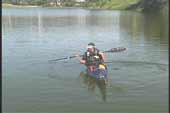
To put this skill into proper perspective let's first look at our standard high sculling brace. Here I am in the correct hand position getting ready to place the power face of my paddle on the water to begin my brace. Note the distance the paddle tip is away from me and the kayak.
When the power face of the paddle is placed on the water I begin the sculling movement. This movement keeps the paddle climbing to the surface to give me continuos support as long as I maintain the sculling action.
When I stop moving the paddle the blade will begin to sink if I have any weight on it. Therefore, I need to be centered over my kayak when I stop sculling if I want to stay dry.
Of course, an advantage of this hand position is no change is required from my normal paddling position. I am also ready to brace on the opposite side.
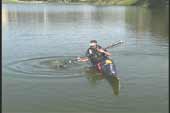
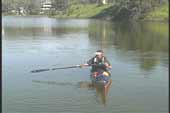
Now let's look at the extended paddle position. The first thing that is obvious is the greater distance the paddle tip is away from me and the kayak when you compare it to the sculling brace setup in normal paddling position as seen in the first picture.
My hand position on the paddle in the extended position is the same distance apart as in normal paddling position. In the picture being shown I have my left hand near the tip of the blade and my other hand is on the paddle shaft. The power face of the working blade is facing the water.
When the power face of the working blade is presented to the water notice how both of my elbows are pointing down. In any high brace it is critical you have your elbows pointing down to reduce your chance of shoulder injuries (See USK article "Shoulder Safety"). In the extended paddle position it is even more important to keep the elbow down on the working side because of the greater leverage on that side. Also, make sure you do NOT reach out too far with the working side. In other words, do NOT straighten out your arm on the working side. If you keep a bend in the elbow and the elbow pointing down you are in a protected position for your shoulder.
Those who paddle feathered (blades offset from one another) your hand grip on the non-working blade will be on the edge of the blade. Those paddling unfeathered will need to hold the flat face of the non-working blade partially in the palm of your hand.
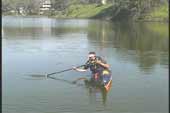
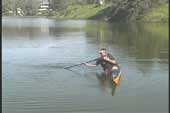
As a quick review, it is important to keep the leading edge of the working blade angled toward the surface when you move it through the water. If the leading edge points down, the blade will dive and you will follow the blade down. I have found diving blades are a result of the paddler not changing the blade angle before moving the paddle in the opposite direction. They attempt to change the blade angle while moving the paddle in the opposite direction. The change in the blade angle needs to occur before the paddle moves in the other direction. In fact I start the angle change at the end of the stroke.
As in all sculling strokes, the range of the stroke is limited because we are looking for maximum support. We should think of a sculling stroke as a shortened sweep stroke. If we move the blade too close to the bow or stern we loose our support. The shorter the stroke the faster you have to move the blade. You will find your own stroke rate, paddle angle and stroke length to fit your needs and style.
As a general rule, the more often you change direction of the the paddle the closer the working blade will stay near the surface. I like to move the blade a bit slower and take a wider sweep because it keeps the blade just under the surface reducing the splashing and noise that is often seen when doing sculling braces. I have seen some sculling braces that churn the water so much it looks like a feeding frenzy of piranhas.
I am a fan of what I call the "mellow scull." Right now I am singing "They call me mellow sculler" to the tune of Donovan's song "Mellow Yellow" (for you 60's folks).
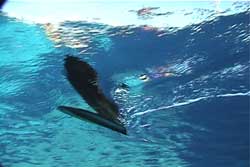
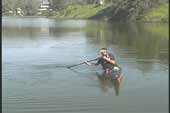

When conditions get rough and I want or need to stop, I enjoy doing the extended paddle sculling stroke as a resting stroke . I just do the stroke and lean ever so slightly to the side of the stroke. I lean toward the stroke because this way I am not being tossed from side to side. I feel very comfortable even when the seas are bouncing me around because I feel secure on that one side.
When I do the sculling brace in the normal paddle position I am as frantic as the next person because when I lean over my capsize point I have more weight on the paddle due to my height, which means I need more lift from my paddle. Getting greater support for my body size is another reason I enjoy the extended paddle high sculling brace.
At first it feels awkward moving from normal paddling position to the extended position but like any other skill it becomes second nature if you practice it. I have no difficulty getting the paddle to the opposite side or back to normal paddling position to perform a different stroke. Again, it just takes practice.
I do caution my students not to use the extended paddle position when side surfing, surfing or when getting hit by a wave. The potential force on the long lever, which can translate to your body, is not worth the risk. I do use the extended paddle sweep stroke when I need to do quick turns in the surf zone, but I am back in normal paddling position before any waves hit me (See USK article "Extended Paddle Forward Sweep Stroke").
In this recent trend of using shorter paddles, for the sake of greater stroke efficiency with a high shaft angle forward stroke, the sea kayaker is losing some potential support from their braces in normal paddling position. When conditions get rough, during capsize recoveries, assisting swimmers or performing on water boat repairs you are going to be more concerned with staying upright than how fast you are moving through the water. Therefore it becomes more important to consider extending the length of your paddle when you need that extra support or greater turning power. The extended paddle sculling brace can give you that extra support when you need it.
Pictures seen above were taken from the USK Video "ABC'S of the Surf Zone" winner of best video of the year from Sea Kayaker Magazine Reader's Poll 2005.
© Copyright USK